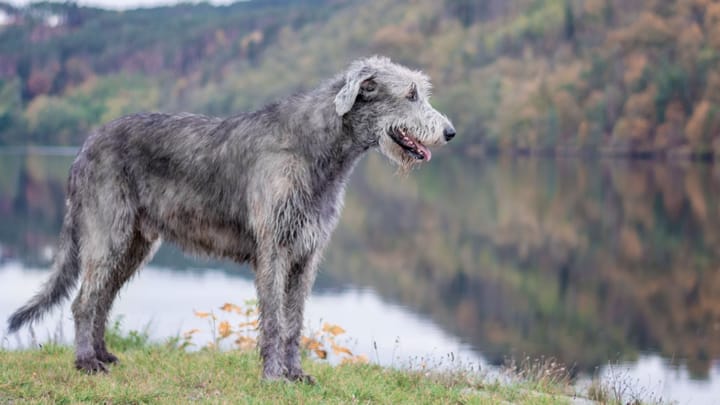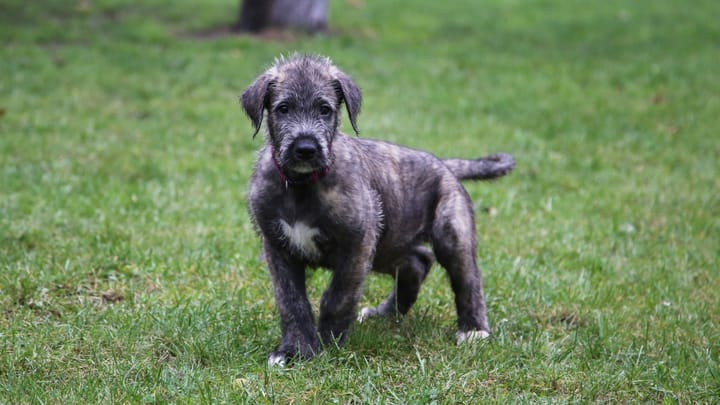Irish Wolfhound
Other names : Wolfhound, Cú/ Cú Faoil


The Irish wolfhound is a gentle, loyal, and exceptionally affectionate dog. Like many greyhound-type breeds, he is very attached to his social group and takes pride and pleasure in protecting them. He is not particularly territorial, but can certainly prove to be a strong deterrent if his family is threatened in any way. Patient and friendly with children, he can blend into family life seamlessly despite his imposing size.
|
Life expectancy |
The Irish Wolfhound has a life expectancy of between 6 and 10 years |
|
Temperament |
|
|
Size |
Large
|
|
Adult size |
Female
Between 28 and 32 in
Male
Between 31 and 34 in
|
|
Adult weight |
Female
Between 88 and 119 lb
Male
Between 88 and 119 lb
|
|
Coat colour
The admissible coat colours are: grey, brindle, red, black, pure white, fawn, wheaten and steel grey. |
Black White Blue Red Sand |
|
Type of coat
The coat is medium-long. The coat is coarse, hard and wirehaired above the eyes and underneath the jaw. |
Long |
|
Eye colour
The eyes are dark. |
Brown
|
|
Purchase price |
The Irish Wolfhound costs between £900 and £1430 |
There was a time when this breed could not be found in a single, so-called ‘commoner’s’ home. Only nobility was allowed to own this dog. He was to be found in several royal courts, namely that of Edward the Third, Henry the Eighth, and Elizabeth the First in England, or Henry the Fourth in France.
More details about the Irish Wolfhound
Irish Wolfhound: Origins and history
Opinions on the Wolfhound’s origins are divided: certain sources claim that the breed is recent (dating back to 19th century), but most experts consider his roots to be very old. It would seem that in 391 B.C., a Roman consul received a gift from his brother in the form of seven large dogs, designed to fight in the arena against lions and bears. The description of this dog is, at any rate, compatible with that of the Wolfhound.
Physical characteristics of the Irish Wolfhound
The Irish Wolfhound is one of the biggest dogs in the world: a sighthound with an elongated and imposing frame, a significantly muscular constitution, and a large croup and back. The paws are long, straight, and of solid bone structure. The head is long and flat, not too wide, with a long and slightly pointed muzzle. The eyes are small and dark, exuding a gentle expression. The ears are small and rose-shaped, like that of the Greyhound.
FCI classification of the Irish Wolfhound
-
Group 10 - Sighthounds
-
Section 2 : Rough-haired Sighthounds
Irish Wolfhound: Characteristics
Irish Wolfhound: Behaviour
Training a Irish Wolfhound
Since the Irish Wolfhound is exceptionally attached to his master, the training process does not tend to be difficult if the methods used are both gentle and firm, coherent and positive. In fact, this dog takes it to heart to please his master, but no display of brutality will ever be tolerated.
Make sure to start laying the disciplinary groundwork for the Wolfhound pup as soon as he integrates the home, to prevent him from picking up any bad habits. What’s more, these ‘bad habits’ could prospectively become dangerous on account of the dog’s bulk once he reaches adulthood.
The basics of dog-training and discipline will therefore continually have to be reinforced, especially recall and healing. He only reaches maturity at the age of 3 or 4, in fact, so commands must be repeatedly taught and mastered.
Irish Wolfhound: Lifestyle
Breed compatibility Irish Wolfhound
Irish Wolfhound: Purchase price
The price of a Wolfhound varies depending on its origins, age, and sex. You have to count an average of £1430 for dogs subscribed to the Kennel Club.
With regards to the monthly budget required to meet the needs of a dog of this size, you have to estimate an average of £70 per month.
Irish Wolfhound: Shedding
Average
Shedding is moderate throughout the year, save for moulting seasons, during which it intensifies. That is when daily brushes will be required.
Irish Wolfhound: Grooming
The maintenance of this wirehaired dog is not complicated but does require some amount of diligence and consistency in order to preserve the beauty and cleanliness of his coat. He doesn’t necessarily need to be bathed, unless he is very dirty of course, but this should remain rare.
Irish Wolfhound: Health
Life expectancy is 8 years on average.
The Irish Wolfhound is relatively robust but, unfortunately, does not have a very long lifespan.
Hot weather is not the Irish Wolfhound’s climate of choice. He will require a spot in the shade and an endless source of fresh water during heat waves, and you should refrain from demanding any physical exercise of him during these times.
Even though he tolerates cold weather and greatly appreciates spending time outside, it is not advised to have him sleep outside, as he clearly prefers to rest within the comfort of his family’s home.
This athletic and frugal dog is not vulnerable to excessive weight gain.
- Bone cancer (osteosarcoma)
- Gastric Torsion Syndrome
- Dilated cardiomyopathy
- Elbow dysplasia
- Retinal dysplasia
- Progressive retinal atrophy
- Von Willebrand disease
- Wobbler Syndrome
- Pneumonia
- Hygroma
- Delicate tail






